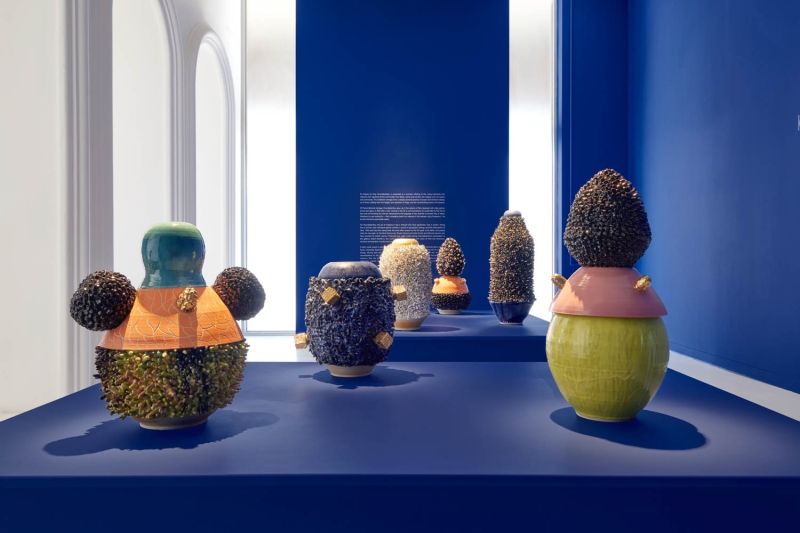Contents
- 1 King Houndekpinkou Reveals His Deep Connection to the Art of Ceramics
- 1.1 Interior Design: Why did ceramics appeal to you?
- 1.2 ID: How did you begin your career as a ceramicist?
- 1.3 ID: How would you describe your background?
- 1.4 ID: Why did you decide to choose the Japanese technique of making ceramics instead of Beniese?
- 1.5 ID: Mythicism and spirituality is a strong theme in your work. Why is that important to highlight?
- 1.6 ID: Your work possesses this incredible shape and comes with bright vibrant colors; why are you so drawn to them?
- 1.7 ID: What inspired your new exhibition “Six Prayers” at the Southern guild gallery?
- 1.8 ID: What was the process of creating “Six Prayers”?
- 1.9 ID: Would you say your work explores biomimicry concepts and are you open to the object interpretation of your work by viewers?
- 1.10 ID Are you exploring other material forms?
For King Houndekpinkou, ceramics is the vessel he chooses to go through life. This explains why he embraces the philosophy: “Everything is in clay and clay is the matter that encompasses all the answers to understand the future and our conditions as humans.” The Franco-Beninese ceramicist has been making art with clay for nearly a decade, an experience that has relished in and has offered him to explore cultures and practice access the world.
Houndekpinkou’s oeuvres bask on a syncretic concept, usually exploring the trans-continental connection between existing cultures; in this case, between the ceramics in Japan and Benin. He doesn’t just explore the technique or the practice of ceramics, but he also finds a means to theorize on the belief systems, stretching into spirituality and mysticism and making references to stories that have shaped these cultures.
In his new exhibition “Six Prayers,” which just finished its run at the Southern Guild Gallery, Houndekpinkou offers six prayers to the Kiln God, with each vessel representing a prayer and shaped as their own complete ritual. Using the meditative art of the wheel-thrown technique by the potter master Shibuta Toshiaki in Bizen, one of the six ancient kilns of Japan known as the Roku Koyō, he infuses an elaborate structure with well-textured forms and vibrant colors—with all of them possessing a spiritual intent.
Interior Design sat down with the ceramicist who discussed his exhibition at the Southern Guild, creative journey, and his practice.
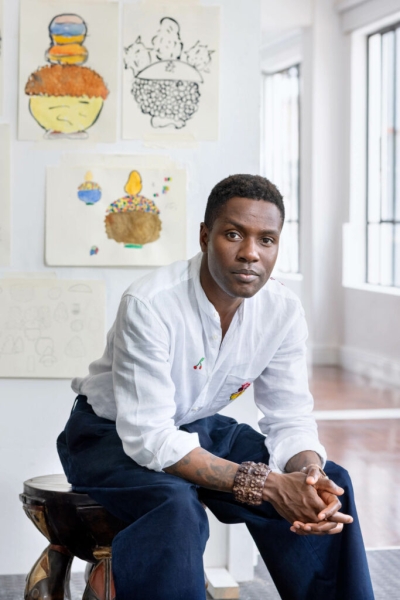
King Houndekpinkou.
King Houndekpinkou Reveals His Deep Connection to the Art of Ceramics
Interior Design: Why did ceramics appeal to you?
King Houndekpinkou: I think ceramics chose me and I responded to the call. When I first encountered claywork, I was soul searching, looking for a purpose that is close to my heart. At the time, I was engaged in a career in communications. While I knew I was creative, I wanted to use my creative skills for more neat and fulfilling purposes, rather than working for companies and using that creative energy elsewhere. I’m not diminishing working for a company; it’s just that they’re not that close to my heart and who I am as a person. So while doing this soul search, I bumped into claywork. And that search led me to Japan, where I discovered ceramics.
ID: How did you begin your career as a ceramicist?
KH: My journey began in Japan in 2012. Then I came back to Paris and decided to keep on soul searching, taking some ceramics classes. At the beginning, I wasn’t really searching for a career; I just wanted to know how nature translated who I am as a person. Since clay is an element of nature that is super old and infused with all the history of humankind, I thought it was the best material to reflect and translate history because it’s so knowledgeable. It’s a huge encyclopedia. We talk about big data nowadays, but I believe clay and soil is where all the data related to human history is stored. I use it as an oracle, really. I embrace it as a way to find answers about the future for myself and for my life, and to just discover more about who I am in the world. Looking back at my career, it’s been amazing. I’m based in Paris, but most of the shows that I’ve been doing have been overseas and internationally. I’m blessed to be having an international career and blessed to know that that’s how it started.
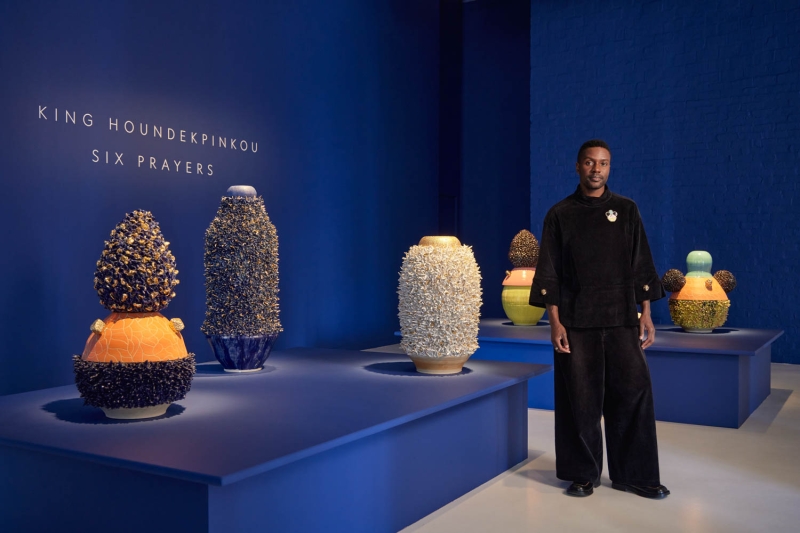
The artist with his work on display in the “Six Prayers” exhibition at the Southern Guild Gallery.
ID: How would you describe your background?
KH: I was born in Montreuil, Paris, but I grew up in the Southern suburbs of France. When I was 19, I went to England to study public relations and communications and then started working in London, coming back to Paris every so often. I also have Beninese heritage, as my mom immigrated from Benin to France so I’m bicultural. Every year, I keep going back to Benin, and at home, I speak Fung and Mena. I understand the language and everything. It was always constantly present despite the distance.
ID: Why did you decide to choose the Japanese technique of making ceramics instead of Beniese?
KH: I think for me, it’s not necessarily about the technique, but it’s about the way of doing, especially when it comes to how you deal with the ceramics and the clay. When I went to Japan in 2012 and started training with my friends, I could sense the way they were addressing the clay and the way they were working. It was really spiritual. You could feel that their Buddhism and Shintoism beliefs were present in the way they practiced the ceramics. That echoed the voodoo cult, the animist voodoo cult of Benin, which is where I saw the similarities. So for me, it happened in a spiritual way and deeply cultural way. But all of that was emphasized through ceramics.
And then, I trained with Toshia Kishibuta, who I would consider my mentor, and he’s based in Vizan. While I was training with him and learning about his way of doing ceramics, he taught me so many values and how to be a man. I feel like he’s my father in the ceramics world. Inevitably, I’m going to keep using all the things that he taught me in my life because, ceramically speaking, that’s how I was born. And this is the guy that raised me. So I’ve got pieces of him that I’m still using today.
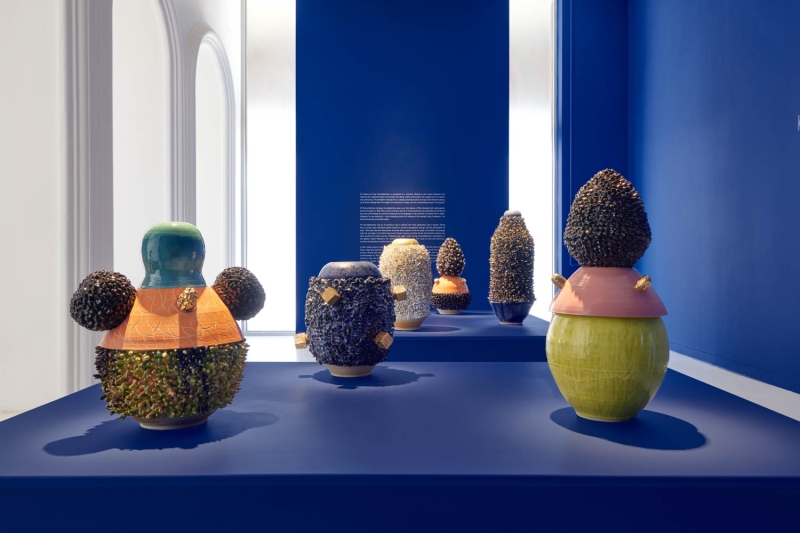
Many of Houndekpinkou’s works draw on ritual ceramics from West Africa.
ID: Mythicism and spirituality is a strong theme in your work. Why is that important to highlight?
KH: It truly is a way of showing the spiritual depth of the material. The ceramics of Benin and West Africa, in general, show that so well and in a way that it speaks to me. When you see all the spikes on my work, these were all inspired from ritual ceramics from West Africa, but used differently. For me, this represents the sacred way of considering clay, ceramics and the the soul that inhabits those ceramics. The synthesis of both these worlds, from the things that I’ve learned from Japan and the things that I’ve learned from Benin, is sacred. Myths are made out of stories and I am telling the stories of now with the ceramics that I use. Because what I’m also trying to do is open a cultural route in the field of ceramics between Benin and Japan. It’s something that has never been done before. If I accumulate enough layers, I can make sure that it’s something that stays in the history of ceramics.
ID: Your work possesses this incredible shape and comes with bright vibrant colors; why are you so drawn to them?
KH: There’s a huge visceral aspect in my work. I mean, the process of making is already tactile, so my work reflects that. I’m mainly doing ceramics to understand more about myself and about the world, and this process is meditative as I put all the layers together. It’s almost like I’m taking out my own matter, my own flesh, and putting it onto the piece. When it comes to color and texture, the texture creates life and makes the color more vibrant. The texture is important as it is the mark of my personality and my soul. The shapes of the vessels reflect something we all know, and we take for granted because we see it every day. But it’s so ingrained in our environment that we don’t see it anymore. And that’s also an interesting shape to show how much history it carries.
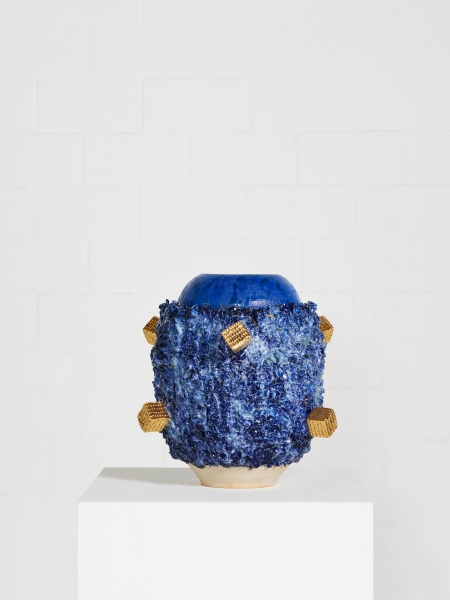
Blue Cavilux: Excavated From The Wonders of The Underworld, 2024. Glazed stoneware, acrylic
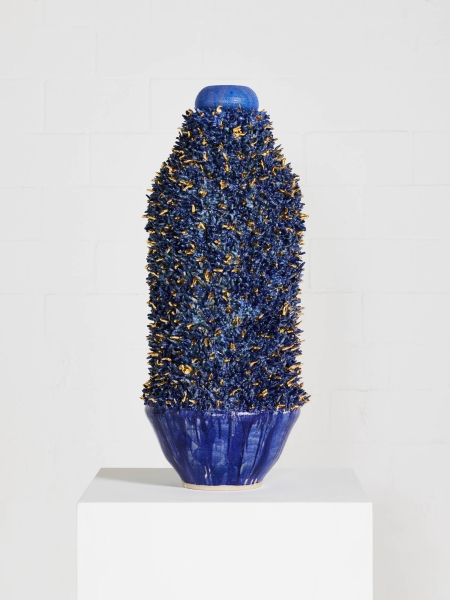
The Sea Widow: To All Those Brave Men Who Carried You Out of The Sea, 2024. Glazed stoneware, acrylic
ID: What inspired your new exhibition “Six Prayers” at the Southern guild gallery?
KH: Well, I did a residency at Southern Guild, where I made these works. And so before each firing, I prayed to the Kiln God that the firing goes well. Because there are six pieces, six pieces equals to six firings. And then there’s the fact that when I throw a piece, I enter a meditative state that is intense and visceral—and so full of intention. It’s charged with a lot of energy. And for me, a prayer is that feeling. It’s an intentional moment where you dedicate time to say something or to be thankful, but also to ask a higher being things. And again, we go back to what clay was first used for 30,000 years ago. It was all very spiritual and intentional. With this exhibition, it goes back full circle with the aspect of prayer, the aspect of intention, and being intentional in telling those stories. And here, there are six prayers because there are six intentions.
ID: What was the process of creating “Six Prayers”?
KH: It took me two months to create these works. At that time, the idea was to work at scale—to create a collection consisting of my signature pieces, but to make them on a larger scale.
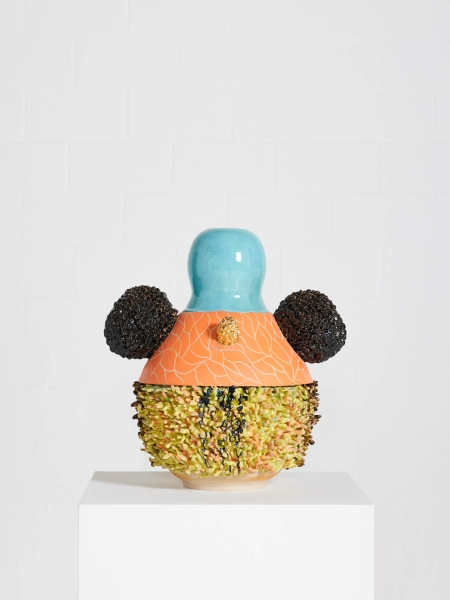
The New Deities’ Platter: Enough For All The Gods To Eat, 2024. Glazed stoneware, acrylic
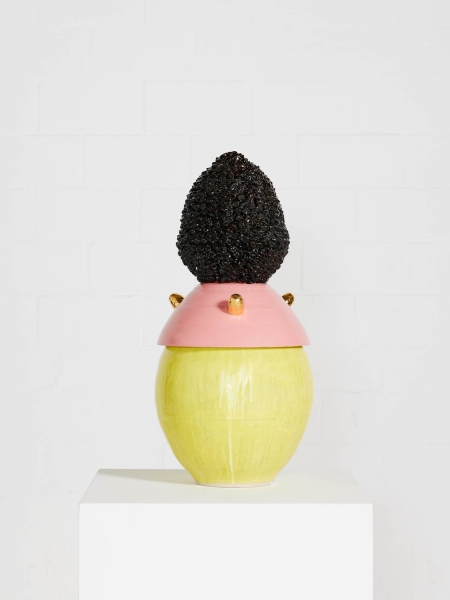
Jumbo Bubble Tea Doll, 2024. Glazed stoneware, acrylic
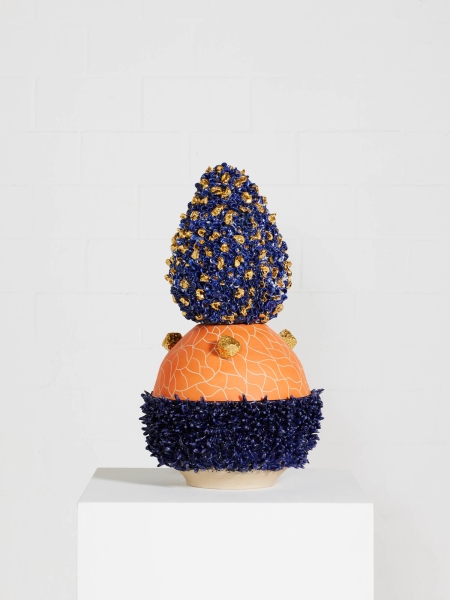
Outer Space Gold Ritual Vessel: I Refused To Let You Down, 2024. Glazed stoneware, acrylic
ID: Would you say your work explores biomimicry concepts and are you open to the object interpretation of your work by viewers?
KH: No, not necessarily. I think my aim is to make sure the pieces are living and breathing, whatever shape they are. If you feel some life in them, then I’ve done my job well. If you are able to connect with them with your own imagination, and it touches your heart in a way that it makes you remember your childhood, it’s a great thing for me. I think it’s important because that’s how people communicate and exchange ideas. For myself, I have to be open to criticism as well. Who am I to say that people should not see my work in a certain way? You always see things in your own perspective, which is based on your background and cultural heritage. But luckily, throughout my career—and being able to show on all five continents—I’ve always had positive feedback. In that, I’d say that there’s something universal in the work that people can feel.
ID Are you exploring other material forms?
KH: Oh yes! I am collaborating with other artisans and designers to create a line of usable artworks. I am always open to collaborate and create new things that are a translation of my current work.
